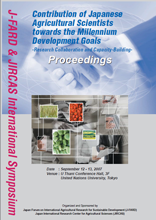Closing Remarks

Dr. Toshihiro Senboku of JIRCAS, on behalf of Mr. Azuma, Chairman of J-FARD;
Thank you very much. My name is Senboku, the Vice President of JIRCAS. On behalf of Chairman
Azuma of J-FARD, I would like to extend my closing remarks. Originally, he was scheduled to
attend and offer these closing remarks. But it seems that he had other prior commitments and I have
been asked to read his closing remarks on his behalf.
Distinguished guests, ladies and gentlemen, allow me to say a few words on behalf of the organizers
at the closing of this symposium. First and foremost, I would like to extend my heartfelt gratitude
for the very large turnout. At the same time I would like to offer my sincere gratitude to the coorganizers,
CGIAR, JICA and the UNU, as well as extend my gratitude to the Minister of Foreign
Affairs, the Minister of Agriculture, Forestry and Fisheries, and other research institutes under
their auspices, and to the University of Nagoya and the International Federation of Agricultural
Journalism for their kind support.
As is well known, the United Nations has set a primary target of halving people suffering from
malnutrition and poverty by the year 2015 under the Millennium Development Goals. This has been
set as the primary target. In order to achieve this target in the domain of agriculture as well, efforts
are being expended around different regions in the world to offer suffi cient supply of food against
the backdrop of growing demand for food in developing countries and also to make contributions
towards poverty reduction in the rural areas. At the center of such efforts are the 15 different centers
under the CGIAR.
On the other hand, Japan depends 60 percent, or more than 60 percent of its food from overseas.
Stability in international demand-supply of food is of basic interest to Japan’s food and agricultural
policy. Also, as a member of the developed community, Japan is being expected to contribute toward
the development of developing countries. So from that perspective, the Ministry of Foreign Affairs
and the Ministry of Agriculture, Forestry and Fisheries and their affi liated research organizations
have been making substantial fi nancial contributions every year.
Having said that, from the standpoint of personnel contribution from Japan, it must be said that we
are lagging behind substantially. If we look back, in terms of wheat and rice which supported the
grain revolution in the past, they were basically Japanese varieties. As this example exemplifi es, the
agricultural research and technologies which Japan has accumulated over the years can meet the
expectations of the international community.
In order to make contributions toward international research with this know-how, we sincerely
hope that the young researchers in Japanese agriculture, forestry and marine research can be
internationally-active and be more meaningful. So this is the objective behind today’s symposium,
and we do hope that this will serve as a catalyst toward increased human and personal contribution
by the Japanese researchers in line with fi nancial contribution.
The keynote speaker of this symposium, Dr. Yakushiji, is indeed the key figure in Japan’s
research collaboration efforts. And he was most encouraging in his remarks. He said, “We should
strengthen science and technology cooperation with developing countries and disseminate Japan’s
technologies.” Also, as was pointed out by Dr. Rabbinge, we need to expend efforts toward cooperation so that the
rainbow evolution can be realized.
Last but not least, I would like to reiterate my heartfelt gratitude to all the participants of the
symposium. Thank you and good bye.
Thank you for your kind attention.
| Date of issued | |
|---|---|
| Creator | Hisao Azuma |
| Publisher | Japan International Research Center for Agricultural Sciences |
| Available Online | |
| Issue | 2007 |
| spage | 139 |
| epage | 140 |
| Rights | Japan International Research Center for Agricultural Sciences |
| Language | eng |
